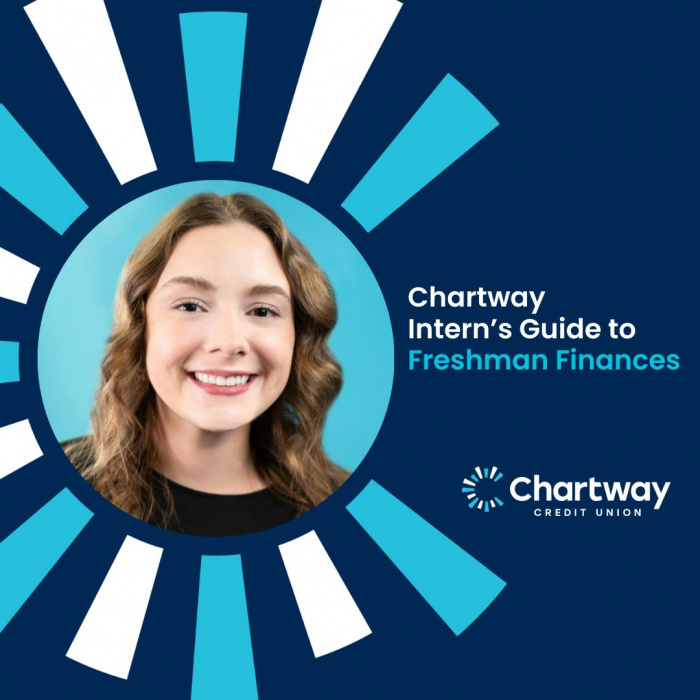Guest Blog: Emily Harrison, Summer 2024 Intern
Are you a high school or early college student who needs advice on how to prepare for a bright financial future? Well, you’re in luck! I’ve created this guide to help you navigate Chartway’s top tips and strategies for financial wellness, preparing you for your college journey before you ever step foot on campus.
Why Financial Literacy Matters for Students
Students who make informed financial decisions take the extra steps to research products and services available to them to help maximize their current financial potential and prepare for their future needs. If you’re like me and want to build a strong financial foundation, participate in all the fun and festivities higher education brings, and treat yourself occasionally without worrying you’ll compromise your ability to pay your bills and save for emergencies, then this is for you!
To gain a broad understanding of the kind of information students want, I interviewed some of my fellow Summer 2024 Chartway interns—current and past college students—and asked them "What financial advice do you wish you had received as a college freshman?" The most common responses were:
- Learning efficient budgeting techniques
- Developing smart spending habits
- Understanding the long-term impact of different loan types
So, in the interest of giving you a head start on thriving financially, let’s dive into these key lessons:
Best Ways to Budget
Are you ready to learn more about how to take control of your finances? Then let’s take a look at your current spending habits and consider how to achieve your vision for your financial future using Chartway’s most popular budgeting methods!
Stacking Your Savings
As you pursue higher education, it’s also a good time to start making smart money moves to stack your savings! So, let’s discuss the primary difference between emergency and savings funds and how you can begin growing both.
Emergency Fund: An emergency fund is intended to cover unexpected costs. To begin building your emergency fund, you’ll need to set a target for how much you’d like to save given the monthly contribution you can afford. Pro tip: Automate transfers to your emergency fund with a Chartway account.
Savings Fund: A savings fund is dedicated to achieving planned financial goals. To build your savings fund, start with deciding what you want to save for and how much you’ll need to attain this goal. Next, calculate your monthly contribution and automate deposits to your savings fund.
Credit Confidence
Time to talk about a typically scary subject: credit! You’ve probably heard how “bad credit” can impact your ability to make large purchases, such as a house or new car. Fear not, I’m here to help you understand how to read your credit report and start building a credit history.
If you already have a credit card or loan, that’s good news—you’re already building credit. If not, you have plenty of time to get started. When applying for a credit card or loan, the loan agreement comes with a specified date on which your payments are due. Each time you make your payment on time, you’ll raise your credit score, a number that shows lenders how trustworthy you are when it comes to paying bills. While there are several factors that impact your score, missing a due date weighs heavily and can lower your score significantly.
You’ll also want to understand what is included in your credit report: your entire credit history, including credit score, current and closed accounts, payment history, loan amounts, and current balances. The report also contains derogatory marks like bankruptcies plus inquiries showing who accessed your credit information—typically you or a lender. You should periodically check that the information the big three credit bureaus (Experian, Equifax, Transunion) have about you is accurate because errors can indicate identity theft.
Smart Borrowing: Loans & Credit Cards
It can be easy to spend when you don’t see an immediate impact but remember that any money you borrow will need to be paid back. In this section, we’ll explore Chartway’s credit card and loan options and how to choose the one that best fits your needs!
Credit Cards: Chartway has four credit card options that are available to students:
- Visa Signature Rewards Card – This is our highest earning credit card, and you earn 1.5 points for each dollar you spend. It’s best for members who want to maximize their credit card earnings.
- Visa Rewards Card – This card option earns members 1 point for each dollar they spend and is best for members who want to earn the introductory $100 statement credit.
- Visa Preferred Rate Credit Card – This is our credit card with the lowest APR and intended for members who want to pay less interest on purchases.
- Visa Secured Credit Card – This credit card holds funds up to the credit limit in a member’s Prime Share account to cover purchases and ensure they’re not overspending. This card can help members build their credit score with on-time payments.
Loans: Chartway has one loan option that is available to undergraduate students:
- Private Student Loan – This line of credit enables undergraduate students to make multiple draws during their college career, while only requiring one initial application. Our Student Choice Loans can accompany federal student loans or stand alone.
Please note: students 18 years and older who have an income may also qualify for a personal loan.
Thank you for joining me on this journey to establish a solid financial foundation! I hope you’ve learned a lot about managing your finances to build a brighter financial future for yourself! Remember, Chartway has got you covered! They offer free financial wellness advice and resources to members, as well as virtual financial education courses, so don’t hesitate to reach out if you have additional questions.

